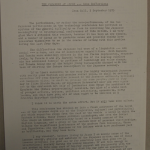The 69th Bilderberg Meeting will take place from 18 – 21 May 2023 in Lisbon, Portugal. About 130 participants from 23 countries have confirmed their attendance. As ever, a diverse group of political leaders and experts from industry, finance, academia, labour and the media has been invited.
353 search results for "cell"
Department of Homeland Security, Federal Bureau of Investigation, National Counterterrorism Center
(U//FOUO) DHS-FBI-NCTC Bulletin: Dissemination of Tactics, Techniques, and Procedures Used by Buffalo Attacker Likely To Enhance Capabilities of Future Lone Offenders
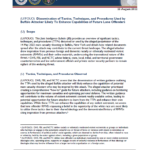
This Joint Intelligence Bulletin (JIB) provides an overview of significant tactics, techniques, and procedures (TTPs) discussed or used by the alleged perpetrator of the 14 May 2022 mass casualty shooting in Buffalo, New York and details how related documents spread after the attack may contribute to the current threat landscape. The alleged attacker drew inspiration from previous foreign and domestic racially or ethnically motivated violent extremists (RMVEs) and their online materials, underscoring the transnational nature of this threat. DHS, FBI, and NCTC advise federal, state, local, tribal, and territorial government counterterrorism and law enforcement officials and private sector security partners to remain vigilant of this enduring threat.
Bilderberg Participant Lists
2022 Bilderberg Meeting Participant List
The 68th Bilderberg Meeting will take place from 2 – 5 June 2022 in Washington, D.C., USA. About 120 participants from 21 countries have confirmed their attendance. As ever, a diverse group of political leaders and experts from industry, finance, academia, labour and the media has been invited.
Department of Homeland Security
(U//FOUO) DHS Bulletin: Moscow’s Invasion of Ukraine Impeding Reach of Russian State Media in the West
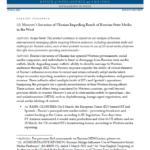
Russia’s invasion of Ukraine has spurred Western governments, social media companies, and individuals to limit or disengage from Russian state media outlets, likely degrading many outlets’ ability to directly message to Western audiences through 2022. This Western response impedes the ability of critical elements of Russia’s influence ecosystem to recruit and retain culturally adept media talent, shape in-country reporting, maintain a perception of media independence, and generate revenue. These setbacks affect multiple facets of RT’s and Sputnik’s operations, hampering the prospects for a speedy reconstitution of their Western-facing efforts. These actions, and others being considered by Western countries, go well beyond previous efforts to counter Moscow’s use of its state media outlets to spread mis-, dis-, and malinformation (MDM), such as deplatforming, foreign agent registration, and social media labeling of content.
Department of Homeland Security, Federal Bureau of Investigation, National Counterterrorism Center
(U//FOUO) Domestic Violent Extremists Emboldened in Aftermath of Capitol Breach, Domestic Terrorism Threat Likely Amid Political Transitions
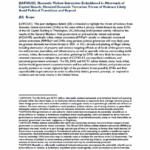
This Joint Intelligence Bulletin (JIB) is intended to highlight the threat of violence from domestic violent extremists (DVEs) in the wake of the 6 January violent breach by some DVEs of the US Capitol Building in Washington, DC, following lawful protest activity related to the results of the General Election. Anti-government or anti-authority violent extremists (AGAAVE), specifically militia violent extremists (MVEs); racially or ethnically motivated violent extremists (RMVEs); and DVEs citing partisan political grievances will very likely pose the greatest domestic terrorism threats in 2021.
Department of Homeland Security
(U//FOUO) DHS Bulletin: Violent Opportunist Tactics Observed During Civil Disturbances 26-31 May
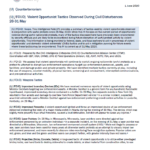
We assess that violent opportunists will continue to exploit ongoing nationwide lawful protests as a pretext to attempt to disrupt law enforcement operations; target law enforcement personnel, assets, and facilities; and damage public and private property. We have identified multiple tactics currently at play, including the use of weapons, counter-mobility, physical barriers, screening and concealment, intercepted communications, and pre-operational activities.
Federal Bureau of Investigation
(U//LES) FBI Bulletin: Anti-Government, Fringe Political Conspiracy Theories Likely Motivate Domestic Extremists to Commit Criminal, Violent Activity
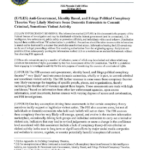
The FBI assesses anti-government, identity based, and fringe political conspiracy theories very likely motivate some domestic extremists, wholly or in part, to commit criminal and sometimes violent activity. The FBI further assesses in some cases these conspiracy theories very likely encourage the targeting of specific people, places, and organizations, thereby increasing the likelihood of violence against these targets. These assessments are made with high confidence, based on information from other law enforcement agencies, open source information, court documents, human sources with varying degrees of access and corroboration, and FBI investigations.
Bilderberg Participant Lists
2019 Bilderberg Meeting Participant List
The 67th Bilderberg Meeting will take place from 30 May – 2 June 2019 in Montreux, Switzerland. About 130 participants from 23 countries have confirmed their attendance. As ever, a diverse group of political leaders and experts from industry, finance, academia, labour and the media has been invited.
China, Federal Bureau of Investigation
(U//FOUO) FBI Counterintelligence Note: Update on Huawei Chinese Government-Subsidized Telecommunications Company March 2018
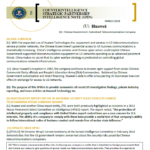
With the expanded use of Huawei Technologies Inc. equipment and services in US telecommunications service provider networks, the Chinese Government’s potential access to US business communications is dramatically increasing. China’s intelligence services and Chinese cyber actors could exploit Chinese Government-supported telecommunication equipment on US networks operating as an advanced persistent threat. China makes no secret that its cyber warfare strategy is predicated on controlling global communications network infrastructure.
U.S. Army
U.S. Army Future Warfare Division White Paper: Operationalizing Robotic and Autonomous Systems in Support of Multi-Domain Operations
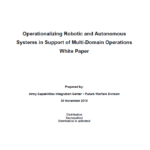
Robotic and Autonomous Systems (RAS) and artificial intelligence (AI) are fundamental to the future Joint Force realizing the full potential of Multi-Domain Operations (MDO 1.5). These systems, in particular AI, offer the ability to outmaneuver adversaries across domains, the electromagnetic (EM) spectrum, and the information environment. The employment of these systems during competition allows the Joint Force to understand the operational environment (OE) in real time, and thus better employ both manned and unmanned capabilities to defeat threat operations meant to destabilize a region, deter escalation of violence, and turn denied spaces into contested spaces. In the transition from competition to armed conflict, RAS and AI maneuver, fires, and intelligence, surveillance, and reconnaissance (ISR) capabilities provide the Joint Force with the ability to deny the enemy’s efforts to seize positions of advantage.
Defense Intelligence Agency
(U//FOUO) DIA Study: Invisibility Cloaking Theory and Experiments
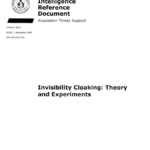
The idea of invisibility has fascinated people for millennia, inspiring many myths, novels, and films. Invisibility cloaking has recently become a subject of science and technology. This paper describes the important current theoretical and experimental developments and tries to project into the future.
National Counterterrorism Center
(U//FOUO) NCTC Counterterrorism Weekly Open Source Digest December 2018
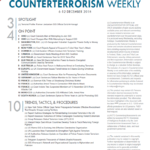
Counterterrorism Weekly is an UNCLASSIFIED//FOR OFFICIAL USE ONLY compilation of open source publicly available press and relevant commentary on issues related to terrorism and counterterrorism over the past seven days. It is produced every Wednesday, excluding holidays. Counterterrorism Weekly is produced by the National Counterterrorism Center and contains situational awareness items detailing ongoing terrorism-related developments which may be of interest to Federal, State, Local and Tribal Law Enforcement, security, military personnel, and first responders. Information contained in the Counterterrorism Weekly is subject to change as a situation further develops.
Florida
Marjory Stoneman Douglas High School Shooting Public Safety Commission Draft Report
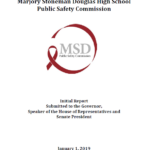
On February 14, 2018, fourteen students and three staff members at the Marjory Stoneman Douglas High School in Parkland Florida were fatally shot and seventeen others were wounded, in one of the deadliest school massacres in United States’ history. The gunman Nikolas Cruz, age 19 at the time of the incident, was a former student of Marjory Stoneman Douglas High School. Cruz was a troubled child and young adult who displayed aggressive and violent tendencies as early as 3-years-old. Cruz struggled in academics and attended several schools. There are reports of behavioral issues at all of the schools he attended. He was under the care of mental health professionals from age 11 until he turned age 18 and refused further services. At 2:19 p.m. on February 14, 2018, Cruz exited an Uber ride sharing service at Marjory Stoneman Douglas High School armed with a rifle and several hundred rounds of ammunition concealed in a rifle bag. He entered the school through an unstaffed gate that had been opened for school dismissal and made his way towards building 12 on the North side of campus. He entered the east side of building 12 through an unlocked and unstaffed door. He made his way through all three floors firing into classrooms and hallways and killing or wounding 34 individuals. He exited building 12 and ran across campus, blending in with students evacuating. Cruz was apprehended approximately 1 hour and 16 minutes after the first shots and charged with 17 counts of premeditated murder and 17 counts of attempted murder.
Nevada
Las Vegas Metropolitan Police Department October 2017 Mass Shooting Final Report
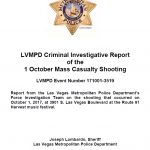
As Engineer Schuck walked up the hallway of the 100 Wing, he observed Security Officer Campos poke his head out of an alcove. Engineer Schuck then heard rapid gunfire coming from the end of the 100 Wing hallway that lasted approximately 10 seconds. When the gunfire stopped, he heard Security Officer Campos tell him to take cover. Engineer Schuck stepped into an alcove and gunfire again erupted down the hallway coming from Room 32-135. The gunfire lasted a few seconds then stopped. The gunfire started again after a brief pause, but Engineer Schuck believed it was directed outside and not down the hallway. Meanwhile, inside the Las Vegas Village over 50 Las Vegas Metropolitan Police Department (LVMPD) personnel were on overtime assignments for the Route 91 Harvest music festival being held at the Las Vegas Village venue. The initial gunshots were heard on an officer’s body worn camera (BWC). As the suspect (Stephen Paddock) targeted the concertgoers with gunfire, officers quickly determined they were dealing with an active shooter and broadcast the information over the radio.
Drug Enforcement Administration
DEA Drug Slang Code Words 2018
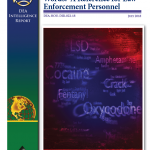
This Drug Enforcement Administration (DEA) Intelligence Report contains new and updated information on slang terms and code words from a variety of law enforcement and open sources, and serves as an updated version to the product entitled “Drug Slang Code Words” published by the DEA in May 2017. It is designed as a ready reference for law enforcement personnel who are confronted with hundreds of slang terms and code words used to identify a wide variety of controlled substances, designer drugs, synthetic compounds, measurements, locations, weapons, and other miscellaneous terms relevant to the drug trade. Although every effort was made to ensure the accuracy and completeness of the information presented, due to the dynamics of the ever-changing drug scene, subsequent additions, deletions, and corrections are inevitable. Future addendums and updates to this report will attempt to capture changed terminology to the furthest extent possible.
Bilderberg Participant Lists
2018 Bilderberg Meeting Participant List
The 66th Bilderberg Meeting is set to take place from 7-10 June 2018 in Turin, Italy. As of today, 131 participants from 23 countries have confirmed their attendance. As ever, a diverse group of political leaders and experts from industry, finance, academia and the media has been invited.
Nevada
Las Vegas Metropolitan Police Department October 2017 Mass Shooting Preliminary Report
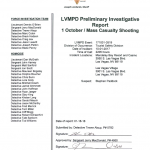
On October 1, 2017, over 22,000 people came together to enjoy a country music festival in Las Vegas, Nevada. On the third and final night of the festival, a lone gunman opened fire into the crowd from the 32nd floor of the Mandalay Bay Resort and Casino. The gunfire continued for over ten minutes, resulting in the deaths of 58 innocent concert goers and injuring more than 700. With law enforcement closing in, the suspect took his own life.
Customs and Border Protection
Customs and Border Protection Alert: Fentanyl Analogues Not Resistant to Narcan (Naloxone)
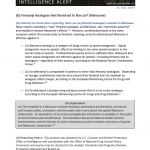
Contrary to recent news reporting, there are no fentanyl analogues resistant to Naloxone. News reports indicated a “new” fentanyl analogue, acrylfentanyl, was “extremely powerful” and implied it resisted Naloxone’s effects. However, acrylfentanyl binds to the same receptors within the human body as fentanyl, meaning correctly administered Naloxone is effective against it.
Delaware, Intelligence Fusion Centers
(U//FOUO) Delaware Fusion Center: Officer Safety Smart Watches
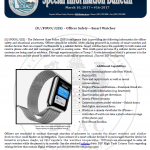
The Delaware State Police (DSP) Intelligence Unit is providing the following information for officer safety and situational awareness. Officers should be mindful, when placing prisoners in custody, of smart watches and similar devices that can connect via Bluetooth to a cellular device. Smart watches have the capability to both make and receive phone calls and text messages, as well as erasing same. This could cause an issue if a cellular device and it’s contents are being used as evidence. Through experimentation at Troop 7, it was determined that if a prisoner is in the detention area and the phone is seized, the watch could still be operational.
New Jersey
New Jersey Office of Homeland Security Guide: Anarchist Extremists – Antifa
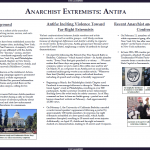
Self-described Antifa groups have been established across the United States and in several major cities, including New York, Philadelphia, Chicago, and San Francisco. A majority of New Jersey-based anarchist groups are affiliated with the Antifa movement and are opposed to “fascism,” racism, and law enforcement. Antifa groups coordinate regionally and have participated in protests in New York City and Philadelphia. There are three loosely organized chapters in New Jersey, known as the North Jersey Antifa, the South Jersey Antifa, and the HubCity Antifa New Brunswick (Middlesex County).
Drug Enforcement Administration
DEA Drug Slang Code Words
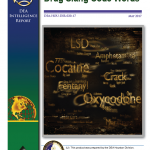
This Drug Enforcement Administration (DEA) Intelligence Report contains information from a variety of law enforcement and open sources. It is designed as a ready reference for law enforcement personnel who are confronted by many of the hundreds of slang terms used to identify a wide variety of controlled substances, designer drugs, and synthetic compounds. Every effort has been made to ensure the accuracy and completeness of the information presented. However, due to the dynamics of the ever-changing drug scene, subsequent additions, deletions, and corrections are inevitable. Further addendums to this report will attempt to capture changed terminology, to the extent possible. This compendium of drug slang terms has been alphabetically ordered, and identifies drugs and drug categories in English and foreign language derivations.
U.S. Army
U.S. Army Mad Scientist Conference Report: The 2050 Cyber Army
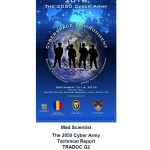
The Mad Scientist 2050 Cyber Army project explored the visualization of the Army’s Cyber Force out to 2050 and its ability to address three major objectives of the Army’s Cyberspace Strategy for Unified Land Operations 2025: What does the cyber environment look like in 2040-2050 (how will cyber influence the environment and the population? What will connecting look like / what will they connect to? What are the drivers influencing this or not)? How do we build an Army Cyber Force that can dominate the cyber domain in the context of the multi-domain battle concept to gain a position of relative advantage? How can we build shared goals and expectations as well as develop an understanding of roles and responsibilities in order to build and maintain partnerships with U.S., and international academia, industry, defense departments/ministries and other agencies to enhance cyberspace operations? What new ideas should we be considering? Co-sponsored by the TRADOC G-2 and the Army Cyber Institute at the United States Military Academy, the 2050 Cyber Army project leveraged submitted papers, an on-line technology survey, and a 13-14 September Mad Scientist Conference that generated the insights synthesized in this report.
Bilderberg Participant Lists
2017 Bilderberg Meeting Participant List
The 65th Bilderberg Meeting will take place from 1-4 June 2017 in Chantilly, Virginia, USA. As of today, 131 participants from 21 countries have confirmed their attendance. As ever, a diverse group of political leaders and experts from industry, finance, academia and the media has been invited.
Bilderberg Archive
Bilderberg Discussion Paper: Some Reflections on the Japanese at Aspen
Department of Homeland Security
(U//FOUO) DHS Intelligence Note: Unknown Cyber Actors Target US Water and Sewage Authority Network
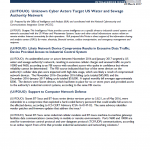
An unidentified actor or actors between November 2016 and January 2017 targeted a US water and sewage authority’s network, resulting in excessive cellular charges and unusual traffic on ports 10000 and 9600, according to an FBI source with excellent access who spoke in confidence but whose reliability cannot be determined. The FBI source indicated that four of the seven devices on the authority’s cellular data plan were impacted with high data usage, which was likely a result of compromised network devices. The November 2016–December 2016 billing cycle totaled $45,000, and the December 2016–January 2017 billing cycle totaled $53,000.

